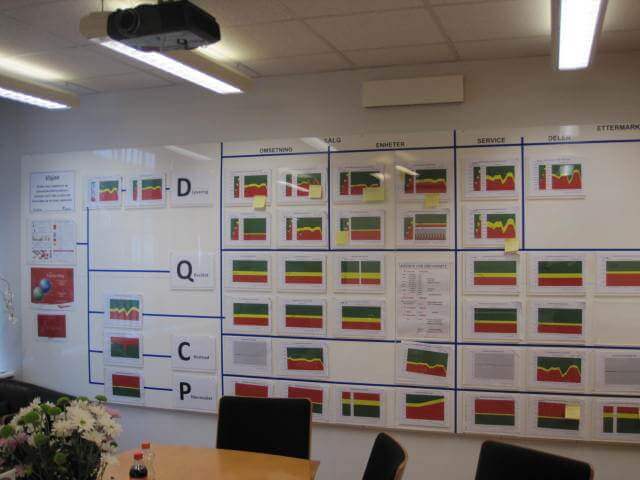Learning to See is the starting point for Learning to Act. By making the facts of any situation clearly visible it is much easier to build agreement on what needs to be done, to create the commitment to doing it and to maintain the focus on sustaining it over time.

However what makes visualisation really powerful is that it changes behaviour and significantly improves the effectiveness of working together to make things happen. It changes the perspective from silo thinking and blaming others to focusing on the problem or process and it generates a much higher level of engagement and team-working. This can be seen at many levels on the lean journey. Here is my list, but I am sure you can think of many more.
Standardized work defined by the team as the best way of performing a task makes the work visible, makes the need for training to achieve it visible and establishes a baseline for improvement. Likewise standardized management makes regular visits to the shop floor visible to audit procedures, to review progress and to take away issues to be resolved at a higher level.
Process Control Boards recording the planned actions and what is actually being achieved on a frequent cadence make deviations from the plan visible, so teams can respond quickly to get back on plan and record what problems are occurring and why for later analysis.
Value Stream Maps make the end-to-end process visible so everyone understands the implications of what they do for the rest of the value creation process and so improvement efforts can be focused on making the value stream flow in a levelled fashion in line with demand.
Control Rooms or Hubs bringing together information from dispersed Progress Control Boards makes the synchronisation of activities visible along the value stream, defines the rate of demand for supporting value streams, triggers the need to escalate issues and to analyse the root causes of persistent problems.
A3 Reports make the thought process visible from the dialogue between senior managers and the author or team, whether they are solving problems, making a proposal or developing and reviewing a plan of action.
Strategy Deployment makes the choices visible in prioritising activities, deselecting others and conducting the catch-ball dialogue to turn high level goals into actions further down the organisation.
Finally the Oobeya Room (Japanese for “big room”) makes working together visible in a project environment. So far it has been used for managing new product development and engineering projects. However organisations like Boeing are realising how powerful it can be in managing projects in the Executive Office (see the presentation and the podcast by Sharon Tanner).
The Oobeya Room is in my view the key to making all this visualisation effective. It brings together all of the above to define the objectives, to choose the vital few metrics, to plan and frequently review the progress and delays of concurrent work-streams, to decide which issues need escalating to the next level up and to capture the learning for the next project (see the Discussion Paper, presentation and podcast by Takashi Tanaka).
But more importantly it creates the context in which decisions are based on the facts and recorded on the wall, avoiding fudged decisions and prevarication. It also ensures that resource constraints and win-lose situations that can arise between Departments are addressed and resolved so they do not slow the project down.
Reviewing progress and delays on a daily or weekly basis rather than waiting for less frequent gate review meetings leads to much quicker problem solving. Because these stand-up meetings only need to address the deviations from the plan and what to do about them they also make much better use of management time.
In short the Oobeya Room brings all the elements of lean management together. Taken to an extreme visual management can of course itself become a curse. I have seen whole walls wallpapered with often out-of-date information that is not actively being used in day-to-day decision making.
Learning how to focus attention on just the right information to make the right decisions in the right way is the way to unlock the real power of visualisation and team-working in the Oobeya Room.